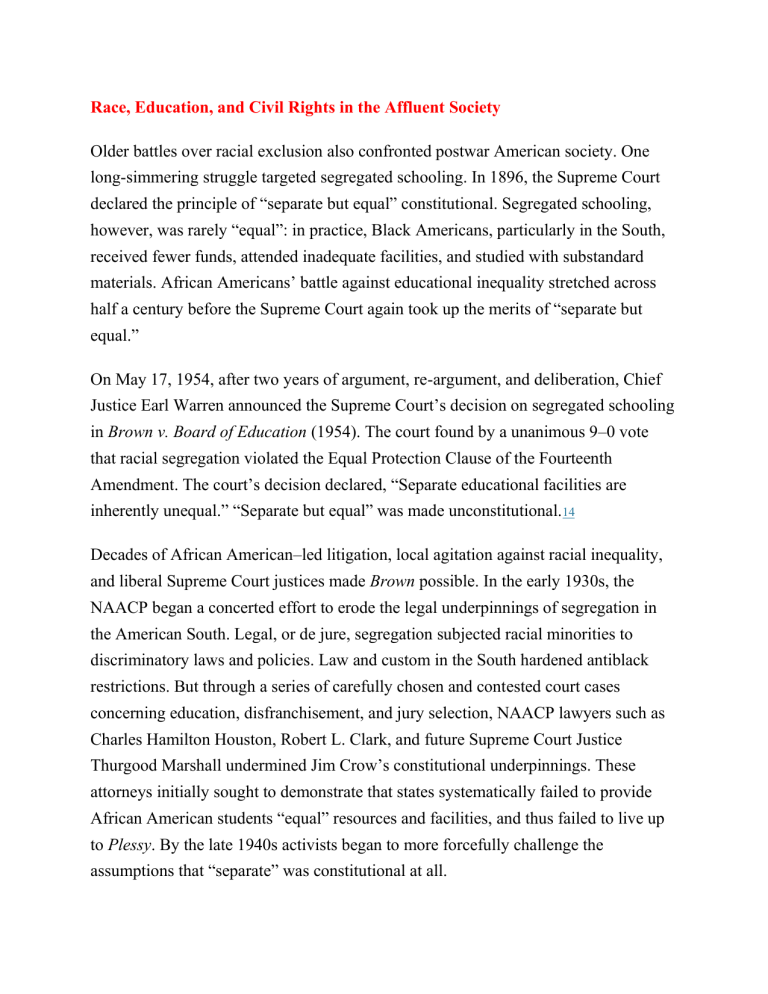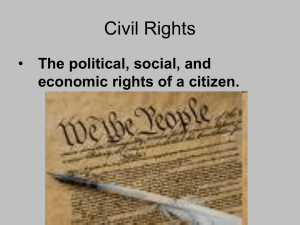
Race, Education, and Civil Rights in the Affluent Society Older battles over racial exclusion also confronted postwar American society. One long-simmering struggle targeted segregated schooling. In 1896, the Supreme Court declared the principle of “separate but equal” constitutional. Segregated schooling, however, was rarely “equal”: in practice, Black Americans, particularly in the South, received fewer funds, attended inadequate facilities, and studied with substandard materials. African Americans’ battle against educational inequality stretched across half a century before the Supreme Court again took up the merits of “separate but equal.” On May 17, 1954, after two years of argument, re-argument, and deliberation, Chief Justice Earl Warren announced the Supreme Court’s decision on segregated schooling in Brown v. Board of Education (1954). The court found by a unanimous 9–0 vote that racial segregation violated the Equal Protection Clause of the Fourteenth Amendment. The court’s decision declared, “Separate educational facilities are inherently unequal.” “Separate but equal” was made unconstitutional.14 Decades of African American–led litigation, local agitation against racial inequality, and liberal Supreme Court justices made Brown possible. In the early 1930s, the NAACP began a concerted effort to erode the legal underpinnings of segregation in the American South. Legal, or de jure, segregation subjected racial minorities to discriminatory laws and policies. Law and custom in the South hardened antiblack restrictions. But through a series of carefully chosen and contested court cases concerning education, disfranchisement, and jury selection, NAACP lawyers such as Charles Hamilton Houston, Robert L. Clark, and future Supreme Court Justice Thurgood Marshall undermined Jim Crow’s constitutional underpinnings. These attorneys initially sought to demonstrate that states systematically failed to provide African American students “equal” resources and facilities, and thus failed to live up to Plessy. By the late 1940s activists began to more forcefully challenge the assumptions that “separate” was constitutional at all. The NAACP was a key organization in the fight to end legalized racial discrimination. In this 1956 photograph, NAACP leaders, including Thurgood Marshall, who would become the first African American Supreme Court Justice, hold a poster decrying racial bias in Mississippi in 1956. Library of Congress. Though remembered as just one lawsuit, Brown v. Board of Education consolidated five separate cases that had originated in the southeastern United States: Briggs v. Elliott (South Carolina), Davis v. County School Board of Prince Edward County (Virginia), Beulah v. Belton (Delaware), Bolling v. Sharpe (Washington, D.C.), and Brown v. Board of Education (Kansas). Working with local activists already involved in desegregation fights, the NAACP purposely chose cases with a diverse set of local backgrounds to show that segregation was not just an issue in the Deep South, and that a sweeping judgment on the fundamental constitutionality of Plessy was needed. Briggs v. Elliott, the first case accepted by the NAACP, illustrated the plight of segregated Black schools. Briggs originated in rural Clarendon County, South Carolina, where taxpayers in 1950 spent $179 to educate each white student and $43 for each Black student. The district’s twelve white schools were cumulatively worth $673,850; the value of its sixty-one Black schools (mostly dilapidated, overcrowded shacks) was $194,575.15 While Briggs underscored the South’s failure to follow Plessy, the Brown suit focused less on material disparities between Black and white schools (which were significantly less than in places like Clarendon County) and more on the social and spiritual degradation that accompanied legal segregation. This case cut to the basic question of whether “separate” was itself inherently unequal. The NAACP said the two notions were incompatible. As one witness before the U.S. District Court of Kansas said, “The entire colored race is craving light, and the only way to reach the light is to start [black and white] children together in their infancy and they come up together.”16 To make its case, the NAACP marshaled historical and social scientific evidence. The Court found the historical evidence inconclusive and drew their ruling more heavily from the NAACP’s argument that segregation psychologically damaged Black children. To make this argument, association lawyers relied on social scientific evidence, such as the famous doll experiments of Kenneth and Mamie Clark. The Clarks demonstrated that while young white girls would naturally choose to play with white dolls, young Black girls would, too. The Clarks argued that Black children’s aesthetic and moral preference for white dolls demonstrated the pernicious effects and self-loathing produced by segregation. Identifying and denouncing injustice, though, is different from rectifying it. Though Brown repudiated Plessy, the Court’s orders did not extend to segregation in places other than public schools and, even then, to preserve a unanimous decision for such an historically important case, the justices set aside the divisive yet essential question of enforcement. Their infamously ambiguous order in 1955 (what came to be known as Brown II) that school districts desegregate “with all deliberate speed” was so vague and ineffectual that it left the actual business of desegregation in the hands of those who opposed it. In 1959, photographer John Bledsoe captured this image of the crowd on the steps of the Arkansas state capitol building protesting the federally mandated integration of Little Rock’s Central High School. This image shows how worries about desegregation were bound up with other concerns, such as the reach of communism and government power. Library of Congress. In most of the South, as well as the rest of the country, school integration did not occur on a wide scale until well after Brown. Only in the 1964 Civil Rights Act did the federal government finally implement some enforcement of the Brown decision by threatening to withhold funding from recalcitrant school districts, but even then southern districts found loopholes. Court decisions such as Green v. New Kent County (1968) and Alexander v. Holmes (1969) finally closed some of those loopholes, such as “freedom of choice” plans, to compel some measure of actual integration. When Brown finally was enforced in the South, the quantitative impact was staggering. In 1968, fourteen years after Brown, some 80 percent of school-age Black southerners remained in schools that were 90 to 100 percent nonwhite. By 1972, though, just 25 percent were in such schools, and 55 percent remained in schools with a simple nonwhite minority. By many measures, the public schools of the South became, ironically, the most integrated in the nation.17 As a landmark moment in American history, Brown’s significance perhaps lies less in immediate tangible changes—which were slow, partial, and inseparable from a much longer chain of events—than in the idealism it expressed and the momentum it created. The nation’s highest court had attacked one of the fundamental supports of Jim Crow segregation and offered constitutional cover for the creation of one of the greatest social movements in American history. IV. Civil Rights in an Affluent Society This segregated drinking fountain was located on the grounds of the Halifax County courthouse in North Carolina. Photograph, April 1938. Wikimedia. Education was but one aspect of the nation’s Jim Crow machinery. African Americans had been fighting against a variety of racist policies, cultures, and beliefs in all aspects of American life. And while the struggle for Black inclusion had few victories before World War II, the war and the Double V campaign for victory against fascism abroad and racism at home, as well as the postwar economic boom led, to rising expectations for many African Americans. When persistent racism and racial segregation undercut the promise of economic and social mobility, African Americans began mobilizing on an unprecedented scale against the various discriminatory social and legal structures. While many of the civil rights movement’s most memorable and important moments, such as the sit-ins, the Freedom Rides, and especially the March on Washington, occurred in the 1960s, the 1950s were a significant decade in the sometimes tragic, sometimes triumphant march of civil rights in the United States. In 1953, years before Rosa Parks’s iconic confrontation on a Montgomery city bus, an African American woman named Sarah Keys publicly challenged segregated public transportation. Keys, then serving in the Women’s Army Corps, traveled from her army base in New Jersey back to North Carolina to visit her family. When the bus stopped in North Carolina, the driver asked her to give up her seat for a white customer. Her refusal to do so landed her in jail in 1953 and led to a landmark 1955 decision, Sarah Keys v. Carolina Coach Company, in which the Interstate Commerce Commission ruled that “separate but equal” violated the Interstate Commerce Clause of the U.S. Constitution. Poorly enforced, it nevertheless gave legal coverage for the Freedom Riders years later and motivated further assaults against Jim Crow. But if some events encouraged civil rights workers with the promise of progress, others were so savage they convinced activists that they could do nothing but resist. In the summer of 1955, two white men in Mississippi kidnapped and brutally murdered fourteen-year-old Emmett Till. Till, visiting from Chicago and perhaps unfamiliar with the “etiquette” of Jim Crow, allegedly whistled at a white woman named Carolyn Bryant. Her husband, Roy Bryant, and another man, J. W. Milam, abducted Till from his relatives’ home, beat him, mutilated him, shot him, and threw his body in the Tallahatchie River. Emmett’s mother held an open-casket funeral so that Till’s disfigured body could make national news. The men were brought to trial. The evidence was damning, but an all-white jury found the two not guilty. Mere months after the decision, the two boasted of their crime, in all of its brutal detail, in Look magazine. “They ain’t gonna go to school with my kids,” Milam said. They wanted “to make an example of [Till]—just so everybody can know how me and my folks stand.”18 The Till case became an indelible memory for the young Black men and women soon to propel the civil rights movement forward. On December 1, 1955, four months after Till’s death and six days after the Keys v. Carolina Coach Company decision, Rosa Parks refused to surrender her seat on a Montgomery city bus and was arrested. Montgomery’s public transportation system had longstanding rules requiring African American passengers to sit in the back of the bus and to give up their seats to white passengers if the buses filled. Parks was not the first to protest the policy by staying seated, but she was the first around whom Montgomery activists rallied. Activists sprang into action. Joanne Robinson, who as head of the Women’s Political Council had long fought against the city’s segregated busing, worked long into the night to with a colleague and two students from Alabama State College to mimeograph over 50,000 handbills calling for an immediate boycott. Montgomery’s Black community responded, and, in response, local ministers and civil rights workers formed the Montgomery Improvement Association (MIA) to coordinate an organized, sustained boycott of the city’s buses. The Montgomery Bus Boycott lasted from December 1955 until December 20, 1956, when the Supreme Court ordered their integration. The boycott not only crushed segregation in Montgomery’s public transportation, it energized the entire civil rights movement and established the leadership of the MIA’s president, a recently arrived, twenty-six-year-old Baptist minister named Martin Luther King Jr. Motivated by the success of the Montgomery boycott, King and other Black leaders looked to continue the fight. In 1957, King, fellow ministers such as Ralph Abernathy and Fred Shuttlesworth, and key staffers such as Ella Baker and Septima Clark helped create and run the Southern Christian Leadership Conference (SCLC) to coordinate civil rights groups across the South in their efforts to organize and sustain boycotts, protests, and other assaults against Jim Crow discrimination. As pressure built, Congress passed the Civil Rights Act of 1957, the first such measure passed since Reconstruction. The act was compromised away nearly to nothing, although it did achieve some gains, such as creating the Department of Justice’s Civil Rights Commission, which was charged with investigating claims of racial discrimination. And yet, despite its weakness, the act signaled that pressure was finally mounting on Americans to confront the legacy of discrimination. Despite successes at both the local and national level, the civil rights movement faced bitter opposition. Those opposed to the movement often used violent tactics to scare and intimidate African Americans and subvert legal rulings and court orders. For example, a year into the Montgomery bus boycott, angry white southerners bombed four African American churches as well as the homes of King and fellow civil rights leader E. D. Nixon. Though King, Nixon, and the MIA persevered in the face of such violence, it was only a taste of things to come. Such unremitting hostility and violence left the outcome of the burgeoning civil rights movement in doubt. Despite its successes, civil rights activists looked back on the 1950s as a decade of mixed results and incomplete accomplishments. While the bus boycott, Supreme Court rulings, and other civil rights activities signaled progress, church bombings, death threats, and stubborn legislators demonstrated the distance that still needed to be traveled.


